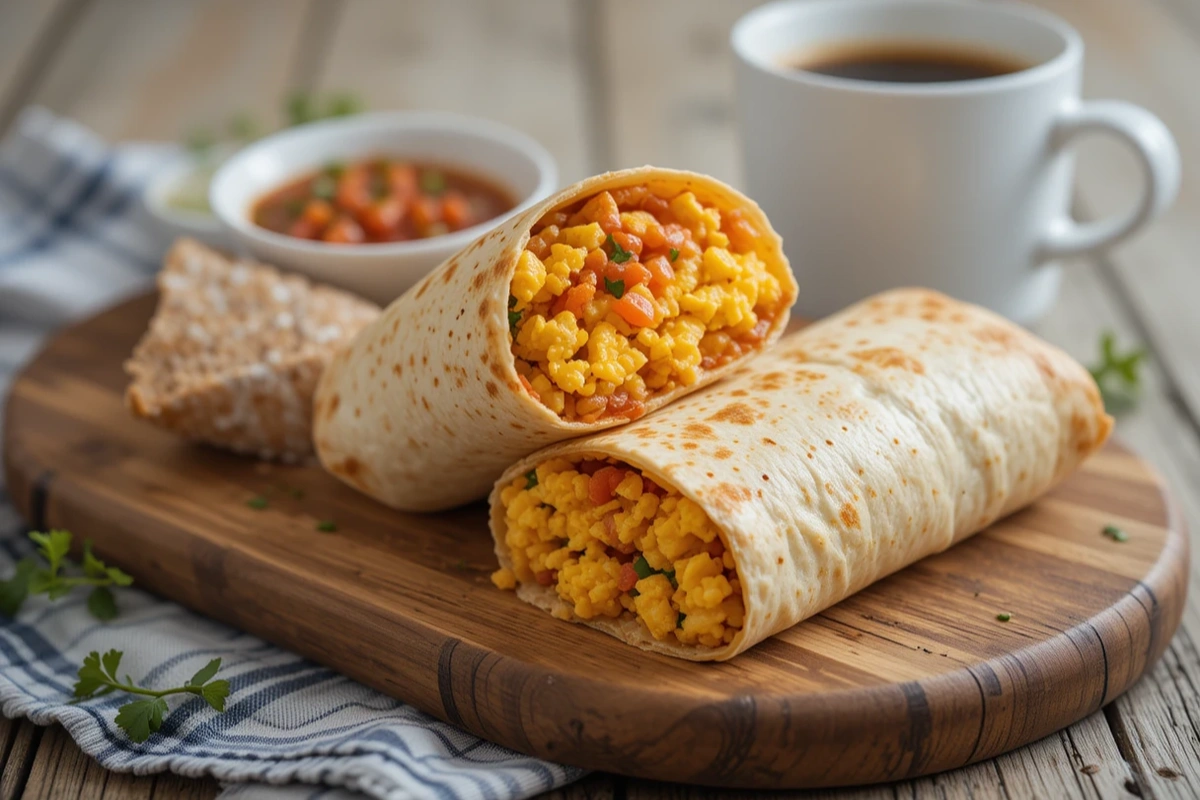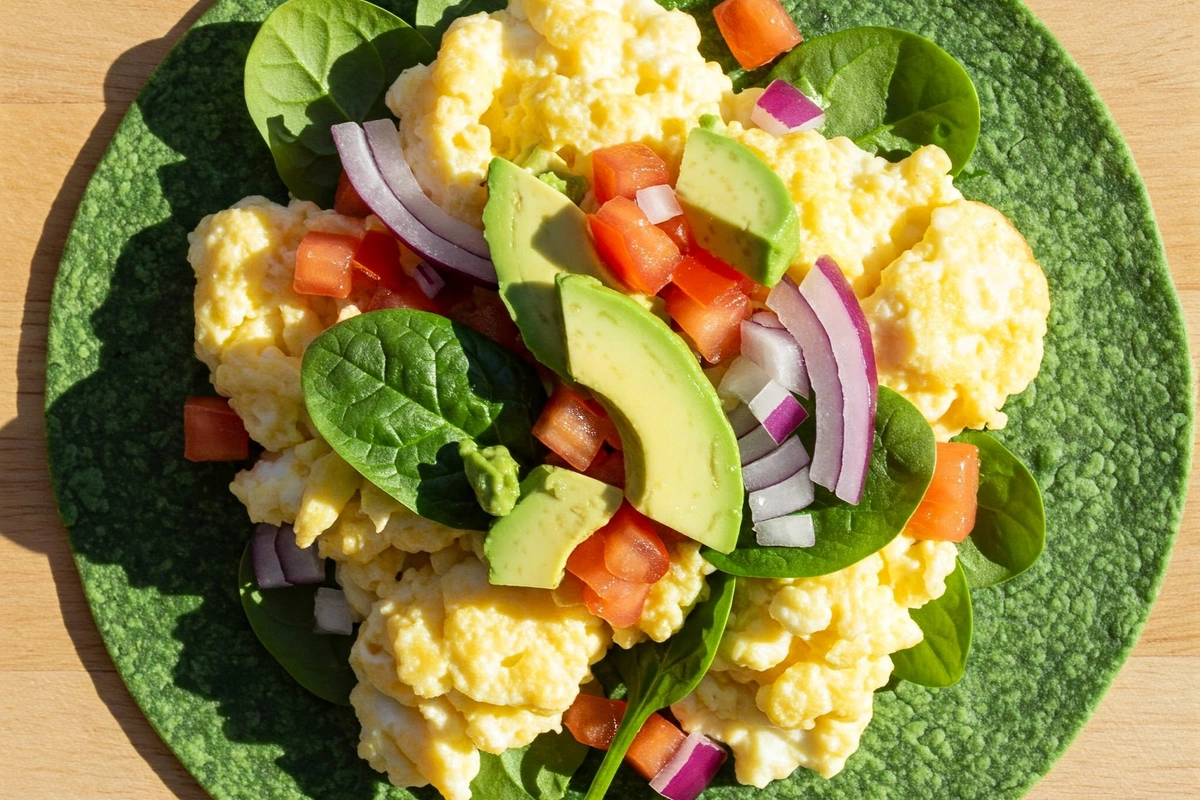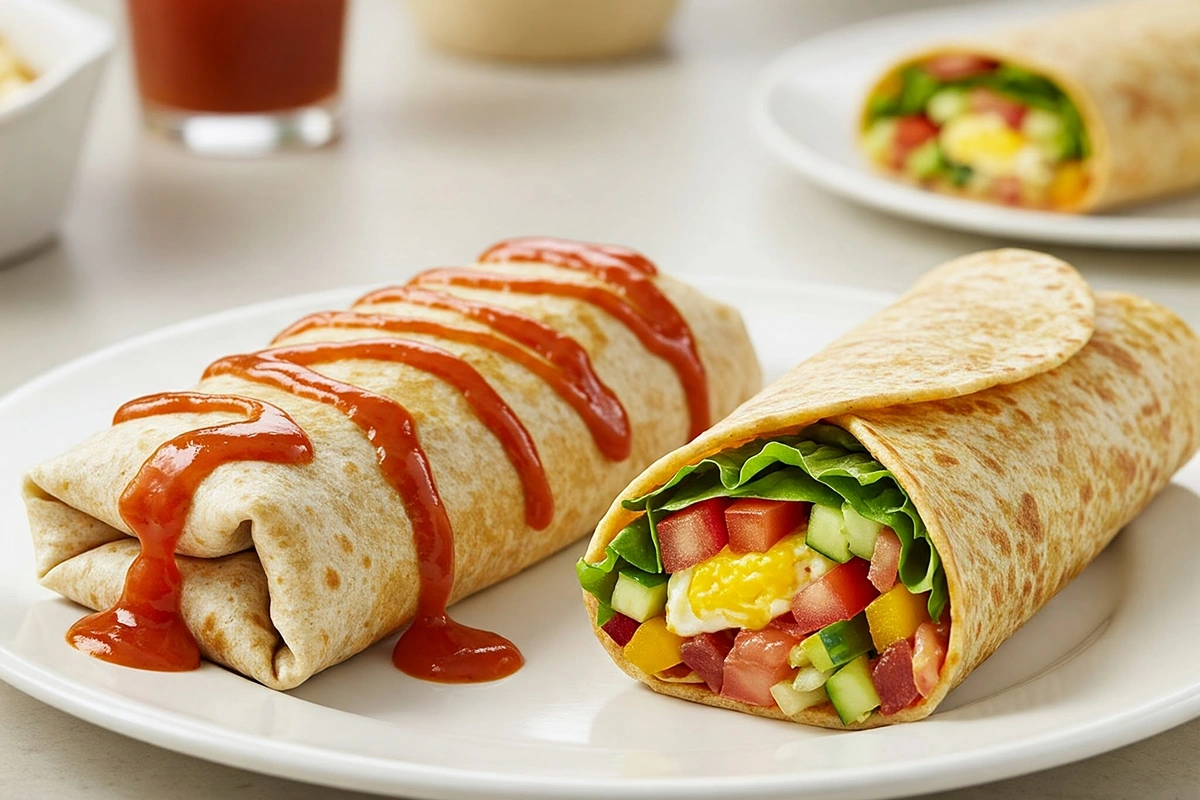What’s the difference between a breakfast burrito and wrap?Discover how burritos differ from wraps. Explore ingredients, textures, and tips for the ultimate flavorful breakfast experience!
What’s more comforting in the morning than a warm, savory hand-held meal? However, each has its own flair, history, and style. It also examines flavor, texture, and nutrition. By the end, you will know what’s the difference between a breakfast burrito and a breakfast wrap? You will also discover helpful tips to craft your perfect morning feast.
In addition, we discuss how both items have evolved and adapted to modern dietary preferences. We then cover various ways to customize them, so everyone can enjoy an ideal morning meal. You will undoubtedly find new ideas to elevate your breakfast routine.
What’s the difference between a breakfast burrito and a breakfast wrap? Overview
Often, these two terms appear interchangeable. Yet, there are crucial differences when we examine the details. Meanwhile, a wrap draws from broader culinary styles. People often see a wrap as a lighter version, using different fillings and less sauce. Nonetheless, both items wrap tasty fillings inside a tortilla or flatbread.
Origins
- Breakfast Burrito Roots: Born from Mexican-American cuisine, especially in the Southwest. Likely popularized in Texas or New Mexico, featuring fillings like eggs, cheese, beans, and salsa.
- Breakfast Wrap Roots: Emerged more recently in casual dining and fast-food settings. Many attribute its rise to international influences, such as Mediterranean or Asian wraps adapted for breakfast.
In many American diners, the breakfast burrito appears with heavy fillings. On the other hand, the breakfast wrap might feature lighter components, like spinach, grilled vegetables, or lean proteins.
Tortilla Types
- Burritos often use a large flour tortilla, thicker than other varieties.
- Wraps, however, can use spinach tortillas, whole-wheat tortillas, or even gluten-free flatbreads.
The question “what’s the difference between a breakfast burrito and a breakfast wrap?” hinges on flavor intensity too. Burritos typically incorporate bold spices like chili powder or cumin. A wrap may use milder sauces, such as ranch or light spreads. Both items rely on scrambled eggs as a foundation. Yet burritos often lean toward more robust southwestern flavors, while wraps can vary widely.
What’s the difference between a breakfast burrito and a breakfast wrap? Ingredient Flexibility
Many people wonder what’s the difference between a breakfast burrito and a breakfast wrap? when they compare ingredient options. Conversely, breakfast wraps might embrace a broader range of global cuisines.
Mexican-American Influence vs. Fusion
- Burritos typically highlight flavors associated with Mexican and Tex-Mex cooking.
- Wraps might incorporate ingredients from Greek, Middle Eastern, or Asian traditions.
Burrito Classics
- Eggs, beans, cheese, and salsa
- Chorizo or bacon for a flavorful punch
- Crispy potatoes or hash browns
Wrap Options
- Lean meats, like turkey or grilled chicken
- Leafy greens or grilled vegetables
- Ranch dressing or hummus for moisture
When deciding which route to take, consider your flavor cravings. If you desire a hearty southwestern taste, the burrito beckons. If you crave variety, a wrap may fit better. Both items can accommodate dietary restrictions. For instance, you can use gluten-free tortillas or vegan cheese alternatives.
What’s the difference between a breakfast burrito and a breakfast wrap? Cooking Techniques
Cooking style also plays a pivotal role:
- Burritos
- Usually grilled or lightly toasted on a pan.
- The goal is a sealed, warm pocket with evenly melted cheese.
- Wraps
- Other times warmed slightly to make the tortilla pliable, but not heavily grilled.
- Grilling is optional, particularly when using fillings like raw veggies.
Because of these differences, burritos often have a toasty exterior. Wraps may remain soft, depending on the recipe. Nonetheless, both can be modified. You can grill a wrap if you crave extra crunch. You can also go lighter on a burrito’s fillings if you prefer fewer calories.
What’s the difference between a breakfast burrito and a breakfast wrap? Flavor Profiles
A key question is “what’s the difference between a breakfast burrito and a breakfast wrap?” in terms of taste. Burritos usually boast a robust, savory profile with a focus on spice. Many recipes feature mild or hot chilies, cumin, onions, and peppers. Conversely, wraps might have gentler seasonings, depending on the chosen cuisine.
Signature Burrito Flavors
- Chili powder or taco seasoning
- Cilantro and fresh lime juice
Popular Wrap Flavors
- Garlic and herb seasoning
- Mild onion or fresh vegetable combos
Although distinct, these flavor profiles overlap in many modern recipes. Indeed, you can add southwestern flair to a wrap or lighten a burrito with veggie-based fillings. The main difference remains the strong Tex-Mex influence in burritos, while wraps feel more open to global fusion.
What’s the difference between a breakfast burrito and a breakfast wrap? Serving Suggestions
When people ask “what’s the difference between a breakfast burrito and a breakfast wrap?” they often care about presentation as well. Burritos typically come wrapped snugly, often cut in half to display the interior. Breakfast wraps sometimes come open-faced or rolled loosely, showing off their colorful ingredients.
Serving a Burrito
- Slice it diagonally, so the layers of eggs, cheese, and meat are visible.
- Pair with salsa, sour cream, or guacamole on the side.
Serving a Wrap
- Cut it into halves or pinwheel slices if you want a fun party snack.
- Include crisp lettuce or sprouts to add bright green color.
Presentation contributes to the overall eating experience. Nonetheless, both burritos and wraps deliver a convenient format perfect for an on-the-go breakfast. Whether you favor a hearty southwestern taste or a lighter vegetable-laden wrap, these meals can adapt to your needs.
Cultural Evolution and Popularity
Nowadays, both burritos and wraps have soared in popularity across the United States. Initially, burritos were mostly associated with Mexican-American communities in the Southwest. Wraps, on the other hand, owe their rise to the widespread demand for handheld, sandwich-like meals. Restaurant chains realized that people enjoyed variety. Thus, they added wrap options featuring different cuisines.
Fast-Food Influence
- Burritos: The fast-food industry embraced them quickly, especially chains with Tex-Mex themes.
- Wraps: Many establishments began serving breakfast wraps to cater to health-conscious consumers.
Modern Culinary Scene
- Burritos: Innovations include everything from vegan burritos to gourmet burritos with lobster or exotic fillings.
- Wraps: Chefs experiment with flavors like Thai peanut sauce, teriyaki chicken, or Indian-inspired fillings.
Despite the differences, both are flexible canvases for culinary creativity. Their adaptability to different diets is remarkable. Whether you are gluten-free, vegetarian, keto, or simply adventurous, both burritos and wraps can incorporate a wide range of fillings.
Nutrition Considerations
A crucial aspect of what’s the difference between a breakfast burrito and a breakfast wrap? relates to nutritional content. Although both can be high in calories, the composition can vary significantly. However, not all wraps are automatically healthier, as some tortillas contain high-calorie additives. Moreover, portion sizes can differ. A super-sized burrito might exceed 1,000 calories. Meanwhile, a smaller wrap might stay under 400 calories.
Ways to Lighten Both Options
- Choose whole-wheat or low-carb tortillas.
- Use egg whites or a plant-based egg substitute.
- Incorporate more vegetables.
Because portion control is vital, be mindful of how many fillings you add. Both a burrito and a wrap can be nutrient-rich if prepared correctly. Focusing on whole-food ingredients keeps them balanced. For instance, you can replace processed meats with black beans, grilled mushrooms, or turkey sausage.
Nutritional Information (Per 100g)
Below is a general guideline. Actual values vary depending on the specific ingredients and amounts.
| Nutrient | Amount (Per 100g) |
|---|---|
| Calories | ~220 kcal |
| Protein | ~10 g |
| Carbohydrates | ~25 g |
| Fat | ~8 g |
| Fiber | ~3 g |
| Sodium | ~500 mg |
Tips for Making the Perfect Breakfast Burrito
- Toast the Tortilla: Warm the tortilla on a skillet. This prevents tearing and enhances flavor.
- Season the Eggs: Whisk in salt, pepper, or a dash of chili powder.
- Layer Your Fillings: Start with cheese on the bottom so it melts quickly.
- Avoid Overfilling: Overstuffed burritos can tear. Moderation ensures a neat roll.
- Optional Grill: After wrapping, place the burrito back on the skillet for a crisp exterior.
You can also experiment with different proteins, like shredded pork or ground turkey.
Tips for Making an Amazing Breakfast Wrap
- Choose Your Base: Whole-wheat, spinach, or gluten-free tortillas add variety.
- Pick Lean Proteins: Grilled chicken, turkey bacon, or tofu keep it light.
- Add Crunchy Vegetables: Lettuce, cucumbers, or bell peppers provide texture.
- Use Light Sauces: Hummus, low-fat yogurt dressings, or avocado spread.
- Roll Carefully: Ensure an even distribution of fillings to maintain structure.
Because wraps can feature diverse global flavors, you can replicate cuisines from around the world. For instance, a Greek-inspired wrap with olives, feta, and tomatoes offers a refreshing twist. This adaptability is what makes wraps appealing to so many.
Customization and Dietary Preferences
- Vegetarian or Vegan
- Use scrambled tofu or plant based egg alternatives.
- Incorporate vegan cheeses and sauces.
- Low-Carb or Keto
- Select low carb tortillas.
- Focus on proteins like eggs, cheese, and meats.
- Gluten-Free
- Opt for corn tortillas or certified gluten free wraps.
- Ensure sauces and fillings are also gluten free.
- Dairy-Free
- Use dairy free cheese or skip cheese entirely.
- Choose salsas, guacamole, or dairy free spreads.
As always, flavor remains paramount. Even if you modify the burrito or wrap , the taste should delight you each morning. Because the format is so flexible, you can adjust to your heart’s content.
Meal Prepping and Storage
Burritos and wraps are both convenient for meal prep. However, their storage methods differ slightly. Wraps can also be prepped ahead but may not freeze as well if they contain fresh lettuce or other fragile .
Storing Burritos
- Cool them completely before wrapping in foil.
- Place in an airtight container or freezer bag.
Storing Wraps
- If meal prepping, store the filling and tortilla separately.
- Assemble just before eating to maintain freshness.
Regardless of your preference, always label containers with the date.
Common Misconceptions
- They Are the Same Thing
- The question remains: what’s the difference between a breakfast burrito and a breakfast wrap? Some people believe there is no difference. In reality, they have distinct flavor profiles and influences.
- Wraps Are Always Healthier
- Not necessarily. A wrap can be loaded with cheese and creamy dressings. Meanwhile, a burrito can be made with fresh vegetables and lean proteins.
- Both Always Contain Cheese
- This is untrue. Vegan versions of burritos and wraps skip cheese entirely, focusing on plant-based proteins.
- A Burrito Must Contain Rice
- Rice is common in some burritos, especially lunch or dinner versions. However, breakfast burritos often skip rice and emphasize eggs.
Understanding these misconceptions helps you appreciate the unique traits of burritos and wraps. When you tailor them to your taste, either can be a healthy, satisfying choice.
Pairing Suggestions
What’s the difference between a breakfast burrito and a breakfast wrap? The sides that complement each dish can also vary. With burritos, spicy or savory sides enhance the southwestern flair. With wraps, lighter or more balanced sides can provide variety in texture and taste.
Burrito Pairings
- Refried beans and rice (for a heavier meal)
- Salsa, guacamole, or pico de gallo
Wrap Pairings
- Fresh fruit salad or yogurt parfait
- Light coleslaw or a simple green salad
Pairing the right side dish adds both nutritional balance and a contrasting flavor. Think about the spices in your main item. Then select sides that harmonize with or balance those flavors.
Conclusion
By now, you might ask: “So, what’s the difference between a breakfast burrito and a breakfast wrap?” The short answer is that breakfast burritos usually emphasize Tex-Mex or Mexican-American flavors, heavier fillings, and robust spices. Breakfast wraps, by contrast, often incorporate a broader range of global tastes, lighter sauces, and varied ingredients. Nonetheless, both revolve around scrambled eggs tucked inside a tortilla or flatbread.
Both are easy to prepare, highly customizable, and perfect for hectic mornings. Next time you plan breakfast, you can confidently decide which style suits your palate. Whether you toast a burrito with melted cheese or fill a wrap with fresh veggies, you will enjoy a hearty, hand held delight.
FAQs : What’s the difference between a breakfast burrito and wrap?
Can I use corn tortillas for a breakfast wrap or burrito?
Absolutely. Corn tortillas can work, especially for a burrito, though they are smaller. Some people prefer the flavor and texture of tortillas. If you need a bigger portion, simply layer two corn tortillas. Meanwhile, wraps commonly use larger flour based options. Still, you can try corn if you enjoy their taste.
Are breakfast burritos always spicy?
Not necessarily. Although burritos often spicy elements, you can control the heat level. If you prefer mild flavors, skip the hot peppers and reduce chili seasonings. You can also balance spices with creamy like avocado or a mild cheese.
Which is more budget-friendly, a breakfast burrito or a wrap?
Both can be made depending on your ingredients. Eggs remain an protein source. Typically, beans cost less than meat. Thus, a bean-centric burrito can be very budget. Wraps can also be cost effective if you use lower vegetables like canned tuna or rotisserie chicken .
Can I freeze a breakfast wrap just like a burrito?
You can, but be selective about fillings. If your wrap contains fresh vegetables or lettuce, they may not freeze well. Burritos handle freezing better, especially if they contain cooked fillings like eggs, beans, and cheese. For best results, keep the wrap’s veggies separate and add them after reheating.
Can I serve either option without eggs?
Certainly. Many plant based eaters skip eggs and opt for tofu scrambles flour “omelets.” This approach works for both . You can also focus on other proteins, like beans, grilled veggies, or tempeh, if you prefer an egg-free meal.
Which tastes better, a breakfast burrito or breakfast wrap?
Taste is subjective. Some people adore the bold, spicy flavors of burritos. Others prefer the lighter approach of wraps. Experiment with different fillings, sauces. Then decide which one aligns best with your morning cravings.
Print
Hearty Breakfast Burrito
- Total Time: 25Min
- Yield: 4 servings 1x
Description
Enjoy a flavorful start to your day with this Hearty Breakfast Burrito. Savory eggs, tasty sausage, melted cheese, and fresh veggies come together in a warm flour tortilla. Each bite bursts with satisfying textures and comforting flavors.
Ingredients
- 4 large flour tortillas (burrito size)
- 1 tablespoon vegetable oil
- 1/2 pound breakfast sausage (or chorizo)
- 4 large eggs, lightly beaten
- 1/2 cup shredded cheddar cheese (or Mexican cheese blend)
- 1/4 cup diced onion
- 1/4 cup diced bell pepper (any color)
- 1/4 teaspoon salt
- 1/8 teaspoon black pepper
- Optional toppings (e.g., salsa, sour cream, avocado)
Instructions
- Cook the Sausage: Warm a skillet over medium heat and add the vegetable oil. Crumble in the breakfast sausage, and cook until browned, about 5–7 minutes. Drain any excess grease.
- Sauté Onions & Peppers: Add the diced onion and bell pepper to the pan. Cook for 2–3 minutes or until the vegetables soften.
- Scramble the Eggs: Pour in the beaten eggs, season with salt and black pepper, and cook gently until the eggs are set and fully cooked, stirring occasionally.
- Combine & Melt Cheese: Lower the heat and sprinkle the shredded cheese on top of the egg mixture. Stir everything to evenly distribute cheese. Remove from heat once the cheese melts.
- Warm Tortillas: Briefly heat each tortilla in a dry pan or microwave to make it pliable.
- Assemble the Burritos: Spoon the sausage-egg-cheese mixture onto each warm tortilla. If desired, top with salsa, sour cream, or avocado. Fold the sides of the tortilla toward the center, then roll it up tightly.
- Serve Hot: Enjoy immediately while still warm. You can also wrap the burritos in foil to keep them hot or save for later.
Notes
- Variations: Swap out sausage for bacon or plant-based protein. Add extra veggies like spinach or mushrooms for a nutritional boost.
- Allergies/Intolerances: Use corn tortillas for a gluten-free option (though they may be smaller). Choose dairy-free cheese alternatives for lactose intolerance.
- Taste Adjustments: Increase or decrease spice by adding chili powder, hot sauce, or jalapeños. For a milder version, omit spicy ingredients and opt for milder cheese.
- Prep Time: 10Min
- Cook Time: 15Min
- Category: Breakfast
- Method: Stovetop
- Cuisine: Mexican-American
Nutrition
- Serving Size: 1/4 of recipe
- Calories: 450 kcal
- Sugar: ~4 g
- Sodium: ~1000 mg
- Fat: ~25 g
- Saturated Fat: ~10 g
- Unsaturated Fat: ~12 g
- Trans Fat: 0g
- Carbohydrates: ~35 g
- Fiber: ~3 g
- Protein: ~20 g
- Cholesterol: ~215 mg
Keywords: breakfast burrito, savory breakfast, quick morning meal, sausage and eggs, Mexican-American breakfast





